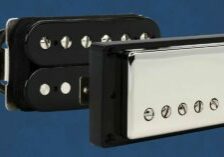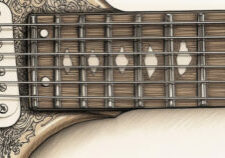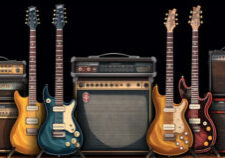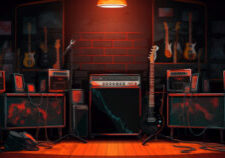This guitar cable guide will help you avoid the crackling, buzzing, and unreliable guitar cables that all of us seem to find. Yeah, bad guitar cables suck. I just had someone come to my house and plug in a guitar, and we messed around for 15 minutes before we figured out the cable was crap. It’s not a great way to sell your gear.
So I decided it was a good time to talk about guitar cables and built a guide / FAQ to help you navigate the world of guitar cables.
We spend so much money on gear that we often times try to go super cheap on accessories like cables. But you might be playing a $2000 amp on a $1000 cabinet and using a $3 cable that is zapping the potential of massive sound! It’s frustrating when subpar cables fail to deliver the sound quality you deserve.
Investing in quality mid-range cables is the key to achieving optimal performance, durability, and affordability. So, whether you’re a beginner or a seasoned guitarist, we’ve got you covered.
Types of Guitar Cables
There are so many different types of guitar cables available, and the price between them can vary greatly. While speaker, microphone, and patch cables can technically be used for guitars, they are not ideal and may not provide the best performance.
Instrument cables are specifically designed for guitars and other instruments. They have the ideal characteristics needed to carry the signals from your guitar to your amplifier or other devices. These cables are available in various lengths, ranging from 10ft to 25ft, allowing you to choose the one that suits your playing style and needs.
When it comes to connectors, there are different types to choose from. The most common type is the standard 1/4-inch phone plug, which is compatible with most guitars and amplifiers. However, there are also other types of connectors available, such as angled connectors, which provide added protection and flexibility.
When buying cables, we want to find the ones with quality connectors that are durable and provide a secure connection. A good quality core and shielded cable are also ideal for minimizing noise and signal loss. Additionally, cables with thick and tough jackets are more likely to withstand the rigors of frequent use and last longer.
I have around 30 mid-level quality cables that I use at home and can recommend these for a home studio.
Importance of Cable Length
The length of your guitar cable plays a crucial role in maintaining the integrity of your signal and minimizing signal loss. I
When it comes to cable length, shorter is generally better. Longer cables can introduce additional capacitance and resistance, leading to signal degradation and loss of high-frequency content. This can result in a dull and muddy tone. Therefore, using the shortest cable to move comfortably on stage or in the studio is recommended.
It is also worth considering the layout of your setup. A longer cable may be necessary to connect everything without straining the cables if you have a pedalboard or multiple effects pedals. However, keeping the cable lengths as short as possible within your setup is still best.
In addition to signal loss, longer cables can be more prone to tangling and getting in the way during performances. They can become a tripping hazard and may limit your movement on stage. Therefore, finding the right balance between cable length and mobility is important.
Different Connector Options
The most common connector for guitar cables is the standard 1/4-inch instrument cable. This connector is compatible with most electric guitars, acoustic-electric guitars, and amplifiers. It provides a secure and reliable connection, ensuring your signal is accurately transmitted.
Another very similar cable is called a TRS cable. TRS cables, or Tip-Ring-Sleeve cables, are typically used for balanced audio connections. This looks just like the 1/4 cable but it has an extra connection on the sleeve. I use two of them to connect my Line 6 Helix amp modeler to my 2 stereo studio speakers.
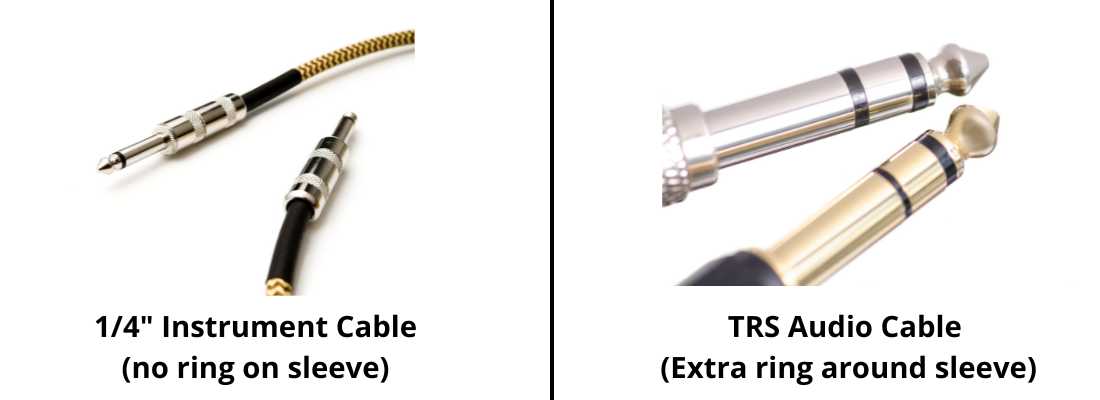
guitar cables and trs cables
If you’re looking for added protection and flexibility, you may want to consider a guitar cable with angled ends. These cables have one end that is angled, allowing for a more ergonomic connection when plugging into your instrument or amplifier. This can help prevent strain on the cable and reduce the risk of damage over time.
Choosing the Right Cable Material
Cable material plays a significant role in determining the overall performance and durability of the cable.
One popular material used for guitar cables is oxygen-free copper (OFC). This type of copper has lower levels of oxide impurities, which can potentially introduce signal distortion. OFC cables are known for their high conductivity and excellent signal transmission, making them a reliable choice for guitarists.
Another material often used for guitar cables is linear-crystal copper (LCC). LCC cables are made using a process that aligns the copper molecules straighter, more uniformly. This results in improved conductivity and signal clarity. LCC cables are favored by some musicians for their potential to enhance the overall sound quality.
Additionally, some guitar cables use tinned copper wire. Tinning the copper wire involves coating it with a thin layer of solder, making it easier to seller and preventing the formation of copper oxides. This can result in better conductivity and a longer lifespan for the cable.
Shielding and Signal Quality
Did you know that proper cable shielding can reduce interference and noise by up to 97%? Your guitar’s signal can be susceptible to unwanted hums, buzzes, and other disruptions without proper shielding.
Different types of shielding can be used in guitar cables. One common type is the electrostatic shield, which helps to discharge static electricity that may be generated when the cable is flexed. This type of shield is often made of materials like rayon braid or carbon-impregnated dacron tape.
Another type of shielding is the conductive plastic shield, which is becoming increasingly popular. This shield is thinner, more flexible, and more effective than tape, making it a great option for reducing interference.
Shielding not only helps to eliminate interference but also blocks external radio frequency interference (RFI), electromagnetic interference (EMI), and electrostatic interference (ESI). This is especially important when playing in live settings or recording environments where there may be other electronic equipment nearby.
Tips for Proper Cable Maintenance
Avoid excessive bending or pulling. Avoid stepping on them or running them over with equipment, as this can lead to breakage or short circuits. If you need to route your cables through tight spaces or around corners, consider using cable ramps or clips to prevent them from being crushed or snagged.
Cleaning your cables is another important maintenance step. Use a soft, dry cloth to wipe away any dirt or debris. You can lightly dampen the cloth with water or a mild cleaning solution if there are stubborn stains or sticky residue. However, make sure to avoid getting any moisture near the connectors or plugs, as this can cause corrosion.
Finally, storing your cables properly when not in use is a good idea. Coil them neatly and secure them with Velcro straps or cable ties to prevent tangling. This means avoiding tight knots or kinks, as they can cause damage to the internal wiring. Instead, loosely coil the cable in a figure-eight pattern to prevent tangling and strain on the connectors. Store them in a cool, dry place away from extreme temperatures or humidity.
Cable Management and Organization
I’m a big fan of using cable ties or Velcro straps to keep your cables neatly bundled together. This is a necessity when talking about a pedalboard. But good ties and straps will prevent them from getting tangled or knotted, making it easier to set up and pack up your gear.
Labeling your cables is another helpful technique for cable management. Labeling each cable with the corresponding instrument or device it is connected to, you can quickly identify and sort them, saving time and frustration. I switch amps a lot and prefer to send modulation and reverb pedals into my send and return. So having those cables labeled saves me time from tracing the cords.
Additionally, consider using cable clips or hooks to secure the cables to the back of your amp or pedalboard, keeping them out of the way and minimizing the risk of tripping over them.
Using Pedalboard Patch Cables
To create a more streamlined and professional setup, consider using pedalboard patch cables. These cables are designed specifically for pedalboards and offer several benefits.
Firstly, pedalboard patch cables are shorter in length, typically ranging from 3 to 12 inches. This minimizes excess cable length and reduces the likelihood of signal loss or interference. Shorter cables also help keep your setup neat and organized, reducing the chance of tripping or getting tangled up during performances.
Furthermore, pedalboard patch cables feature compact connectors that allow for a tighter and more efficient pedalboard layout. These connectors are often right-angle or low-profile, enabling pedals to be placed closer together and maximizing space on your board. This is especially useful if you have many pedals or a smaller pedalboard.
In terms of performance, pedalboard patch cables are made with high-quality materials and construction techniques to ensure optimal signal transfer. They often have high-quality connectors, such as gold-plated or nickel-plated plugs, minimizing signal loss and maintaining the integrity of your tone.
I like to use pancake patch cables as they give me plenty of room between pedals. Here are the ones I order from Amazon and I’ve never had a problem with one.
Honest Kin Pancake Patch Cables
Benefits of Braided Cables
One of the main benefits of braided cables is their durability. The braided design provides extra protection against breakage, ensuring that your cable will last longer and withstand the rigors of regular use.
Additionally, the braiding helps to prevent tangling and knotting, making it easier to set up and pack away your cables without any hassle.
Another advantage of braided cables is their flexibility. The braided construction allows for greater flexibility, making it easier to maneuver and position your cable without any strain. This flexibility is especially useful for guitarists who like to move around on stage or have a dynamic playing style.
In terms of performance, braided cables offer excellent signal clarity and noise reduction. The braided design helps to shield the cable from interference, minimizing any unwanted noise or hum that can often occur with lower quality cables. This ensures that your guitar sound remains clean and clear, without any unwanted distractions.
I use higher quality braided cables for that cable that runs from my guitar to my pedalboard or guitar straight to amp. This is the cable that will get plugged / unplugged all the time and will generally take a bigger beating then other cables. Here are the ones I use:
Frequently Asked Questions about Guitar Cables
Can you use a TRS cable to plugin a guitar?
They are commonly used for professional audio equipment like mixers, amplifiers, and studio gear. These cables are designed to transmit a balanced audio signal, which helps minimize noise and interference over long cable runs. However, guitars usually have unbalanced outputs. Using a TRS cable for your guitar can result in signal loss and degradation. It is best to use a dedicated instrument cable specifically designed for guitars. These cables will provide optimal signal quality and minimize any potential issues.
How long do guitar cables last?
Guitar cables, when properly cared for, can last a long time. On average, a well-made guitar cable can last anywhere from 5 to 10 years or even longer. However, the lifespan of a guitar cable can vary depending on factors such as usage frequency, handling, and storage.
Regular maintenance, such as cleaning the connectors and keeping the cable away from sharp objects or excessive bending, can greatly extend its lifespan. It’s also important to invest in high-quality cables from reputable brands, as they are made with durable materials and robust construction.
So, take good care of your guitar cables, and they will continue to serve you faithfully for many years of rocking out.
Are bass and guitar cables the same?
Both bass and guitar cables are designed to transmit the electrical signal from your instrument to the amplifier or other audio equipment. They have the same connectors and are built to handle the high impedance output of electric guitars and basses. They serve the same purpose and can be used interchangeably without any issues.
Are coiled guitar cables better?
In some cases, yes! Coiled guitar cables, with their spring-like design, offer a visually appealing and practical solution for those who want to prevent cable tangling and create a stylish stage presence.
These cables are particularly beneficial for guitarists who tend to move around a lot during performances. The coiling allows for more flexibility and freedom of movement, without sacrificing signal quality.
Additionally, coiled cables can help reduce strain on the cable and connectors, preventing breakage and extending the lifespan of the cable.
Coiled cables can be slightly heavier and bulkier than straight cables, so they may not be ideal for all situations.
Are guitar cables mono or stereo?
Guitar cables are typically mono and not stereo. This means that they are designed to carry a single audio signal.
Why do guitar cables go bad?
There are several reasons why guitar cables go bad over time. One common cause is frequent bending, twisting, and pulling. These actions put stress on the cable and its internal components, leading to issues like broken wires, loose connections, and signal loss.
Environmental factors also play a role in cable degradation. Temperature changes and exposure to moisture can contribute to the deterioration of the cable. If the cable is not handled and stored properly, it can further accelerate the process of wear and tear.
How long do guitar cables last?
The lifespan of a guitar cable can vary depending on its quality and usage. Generally, mid-range guitar cables priced from $20-$50 offer the best balance of performance, durability, and affordability. These cables can last for 10+ years with regular use. If you take proper care of your cables, you can maximize their lifespan.
Conclusion
So, its always a struggle to find a balance between price and quality. If I had to use high-end cables on every connection that would run me over $1000. So I’m usually looking for that mid-tier that will cost under $20 a cable.
Sometimes, you might not even realize the cable is causing the extra noise. So if I start hearing hum or additional interference, I’ll replace the cable with a more expensive cable to make sure the cable isn’t the problem.
Otherwise, you sometimes just have to try out a lot of cables to find that sweet spot between performance, durability, and affordability.





